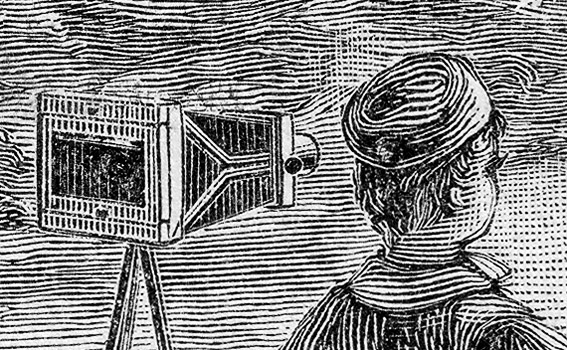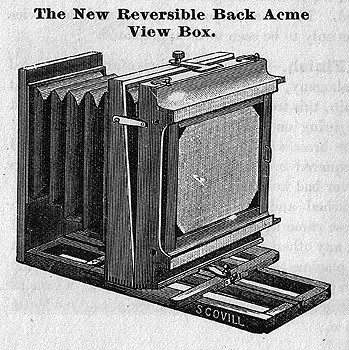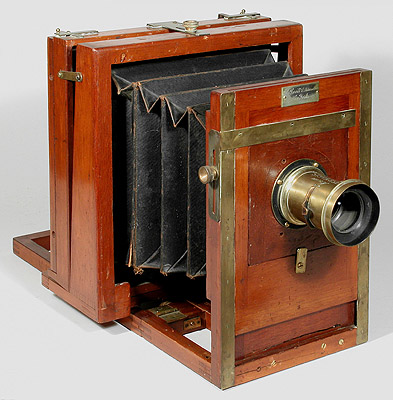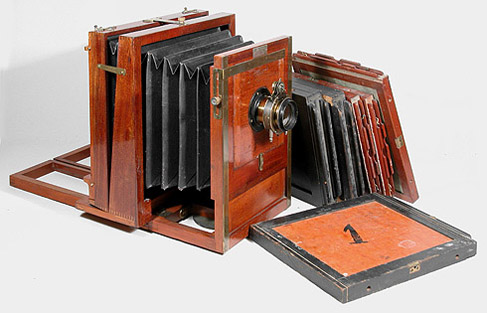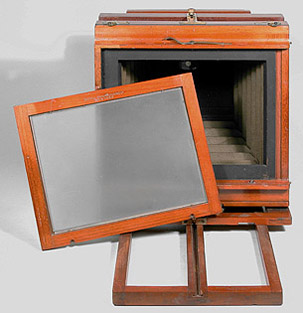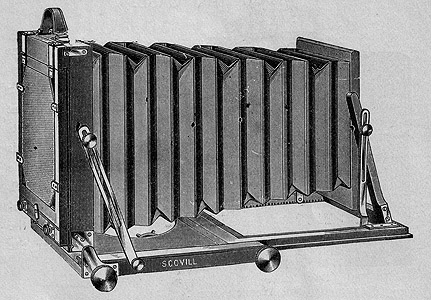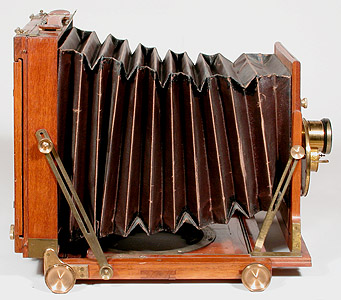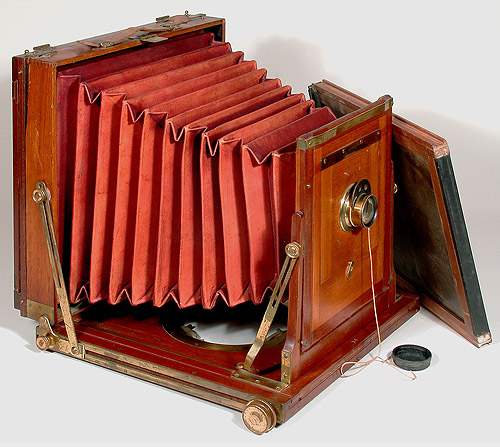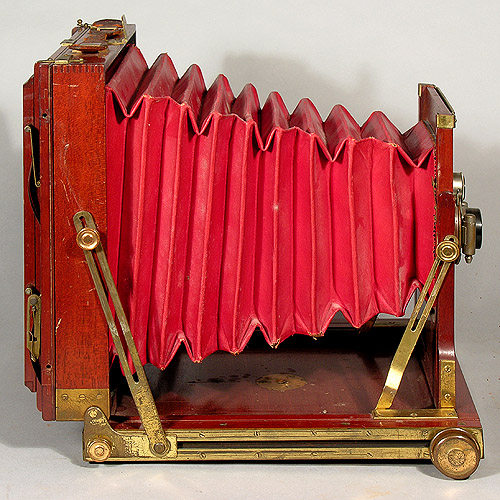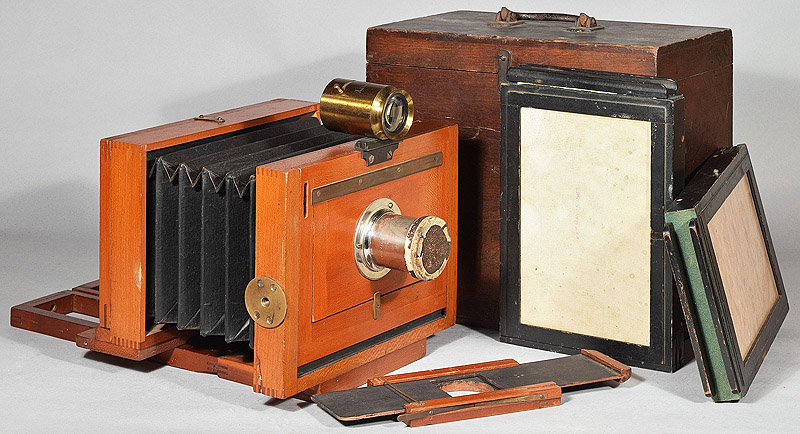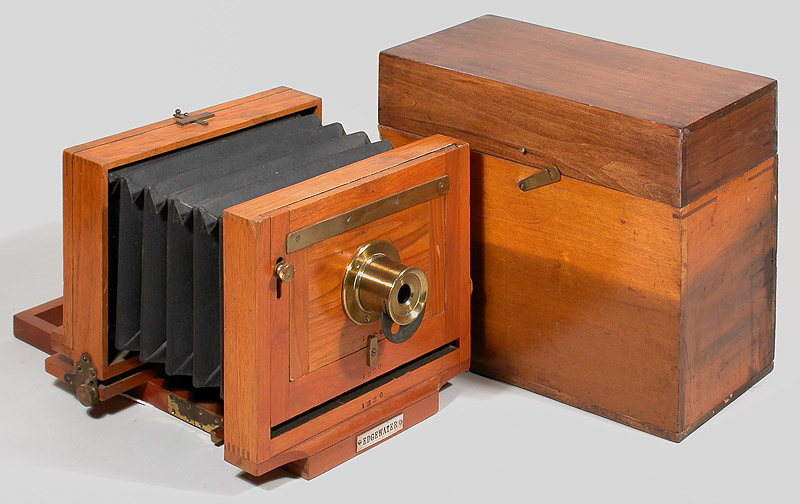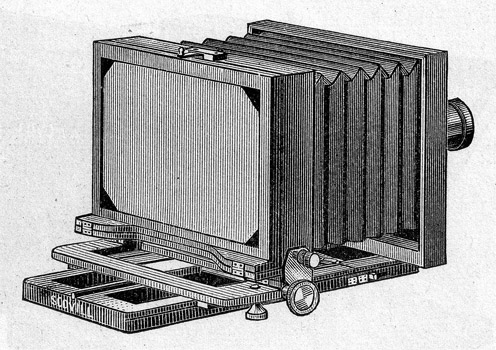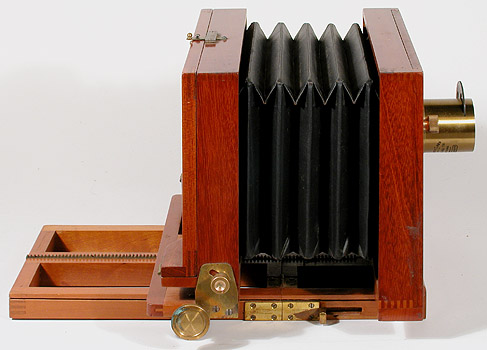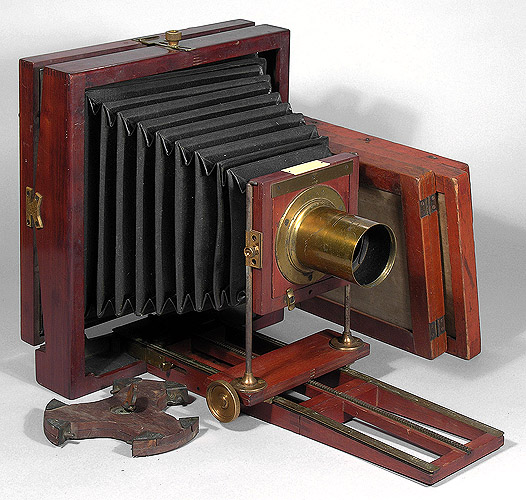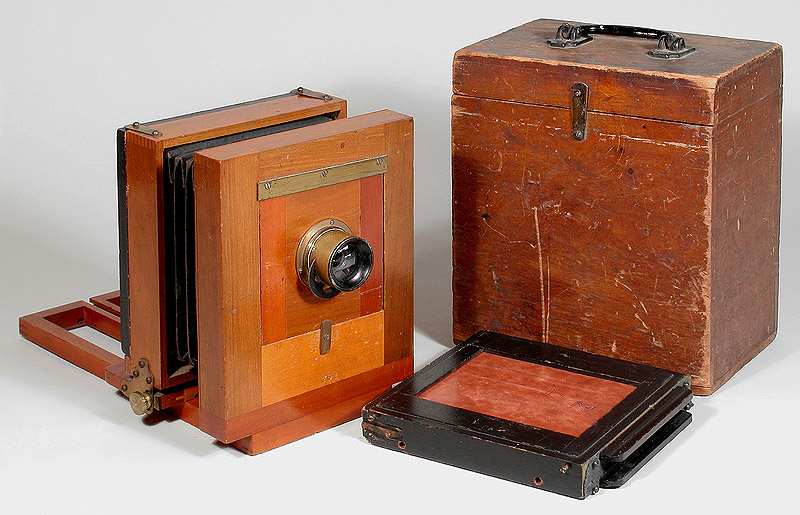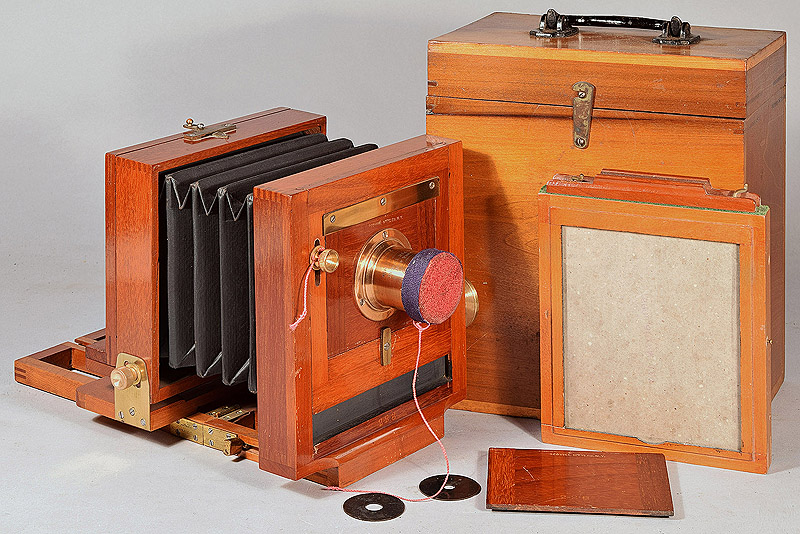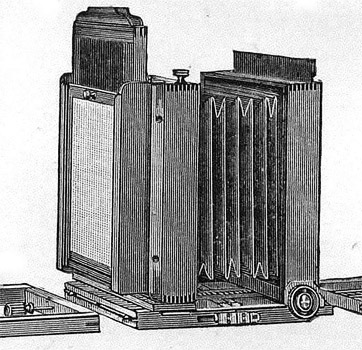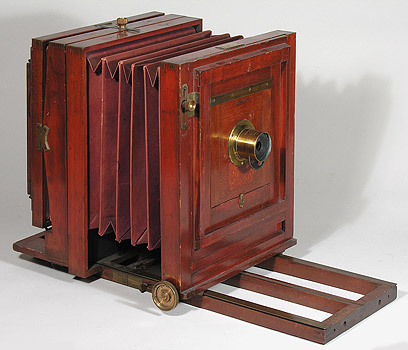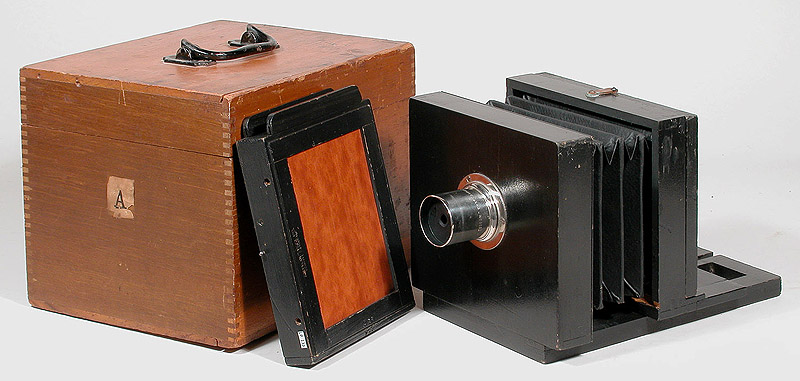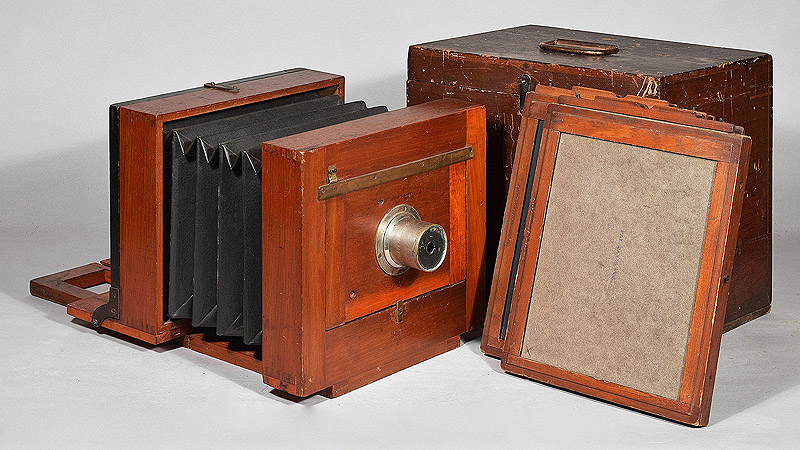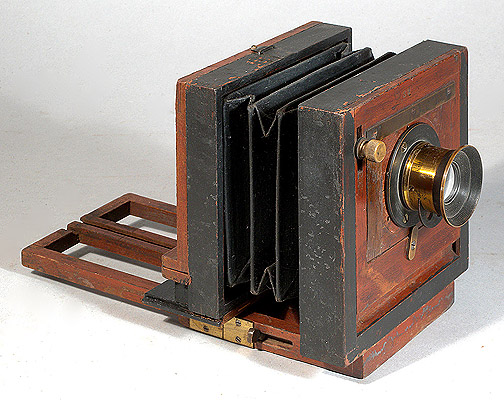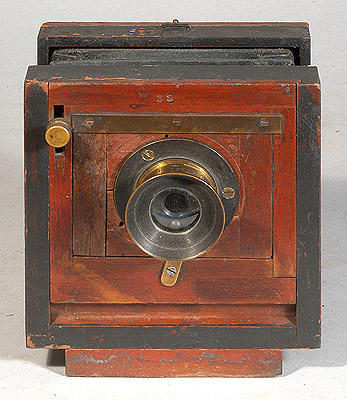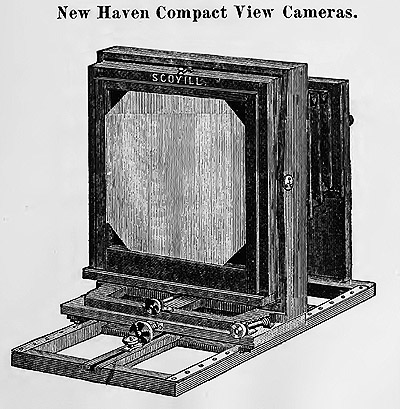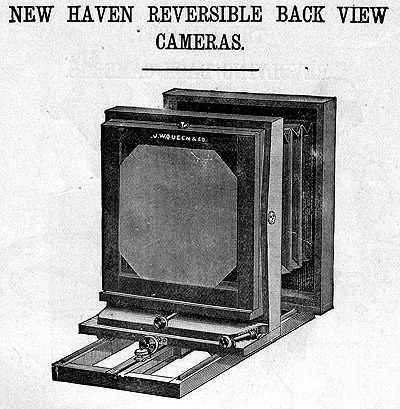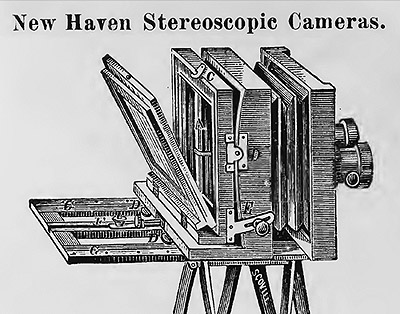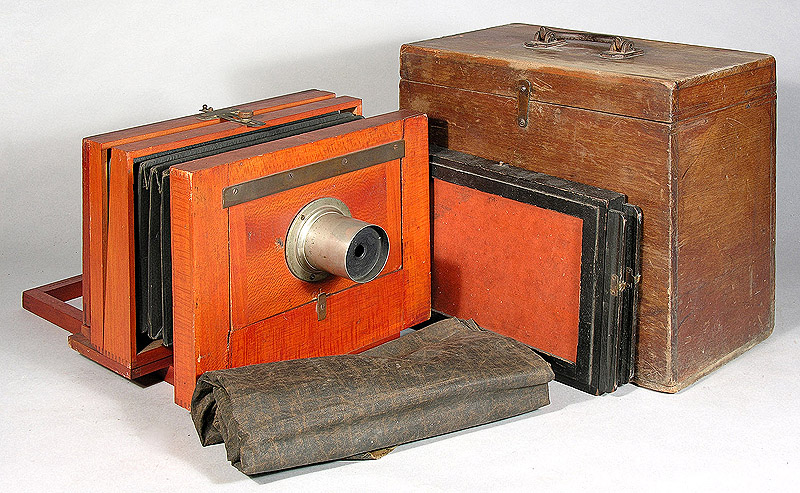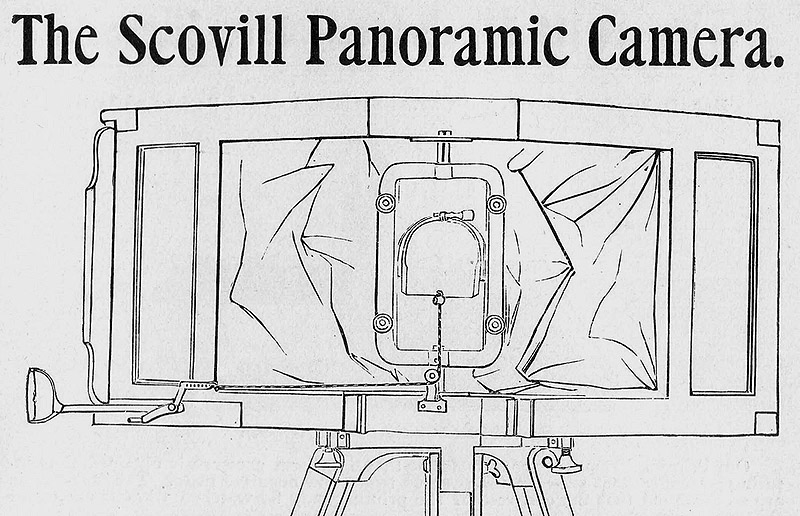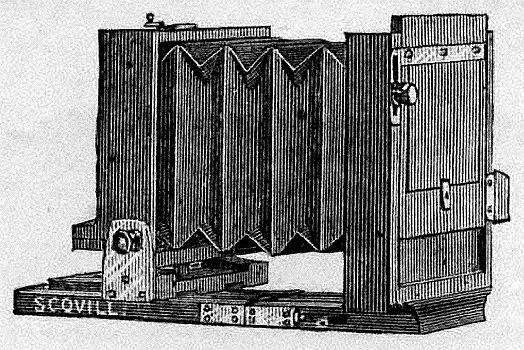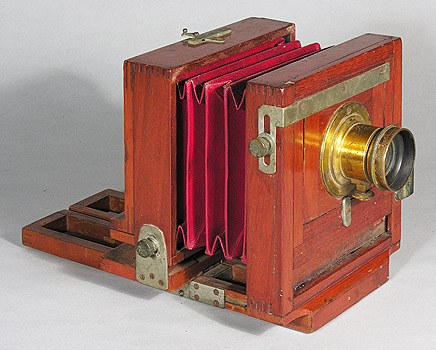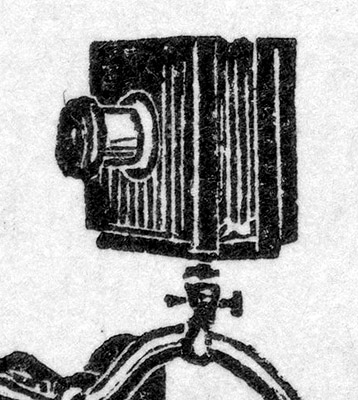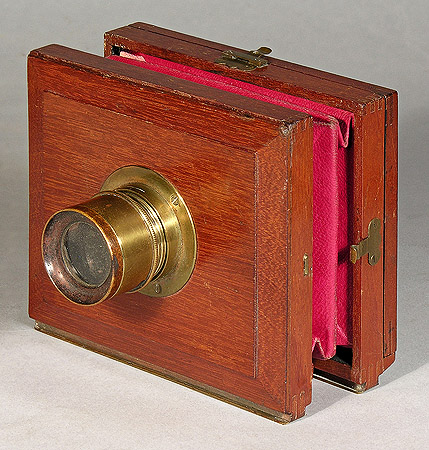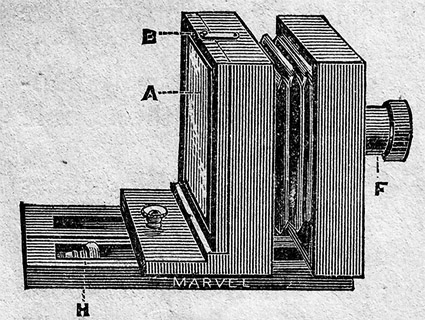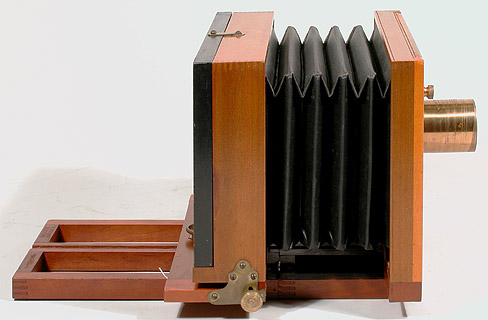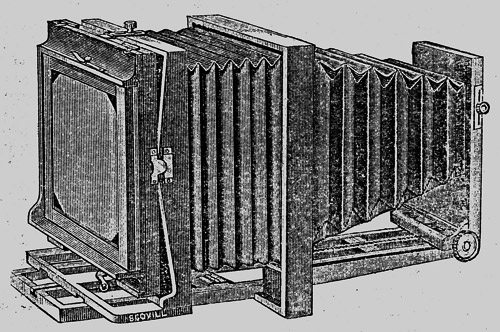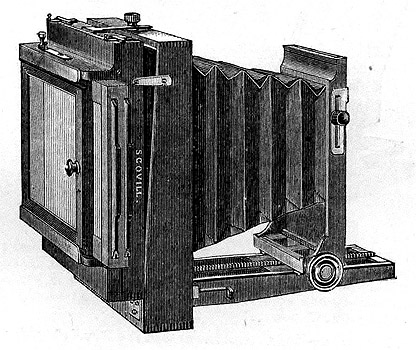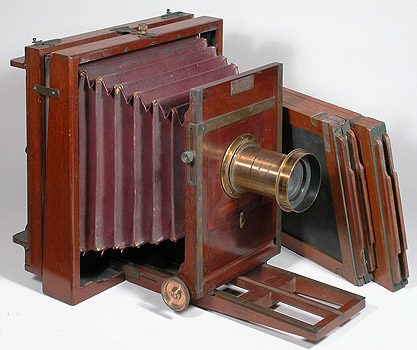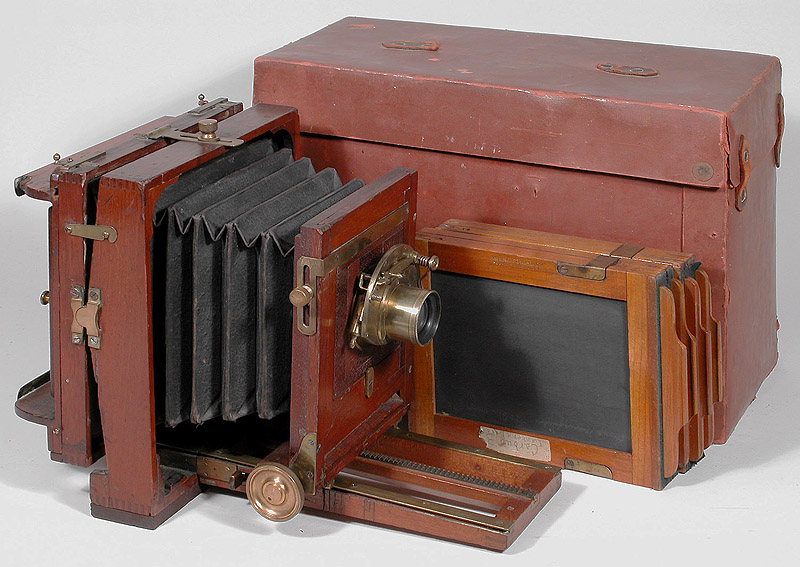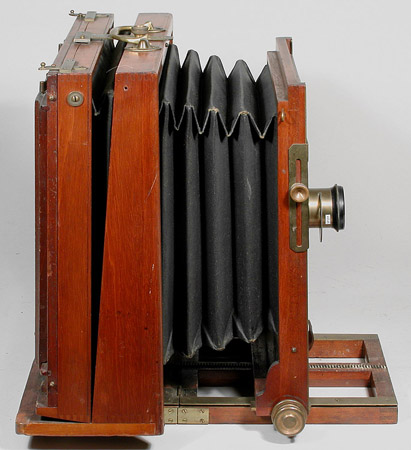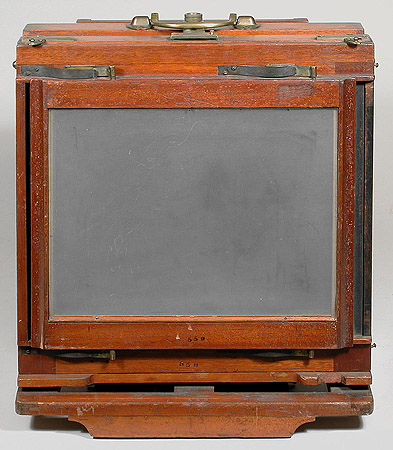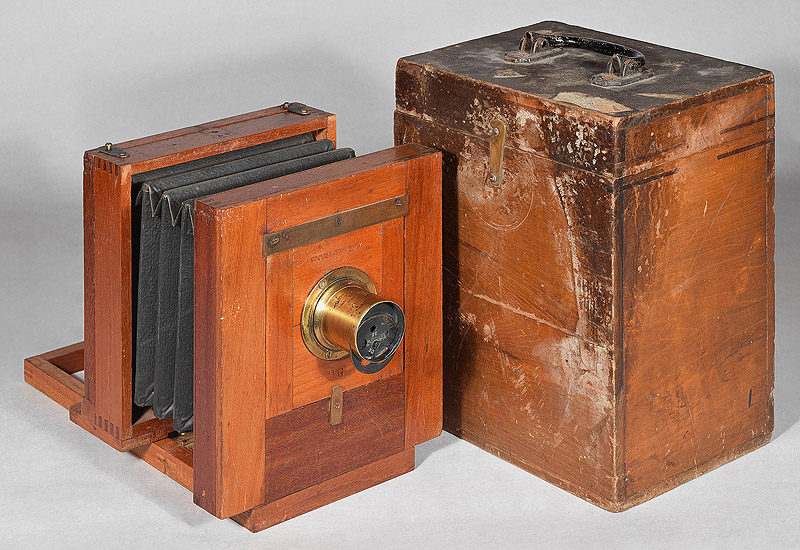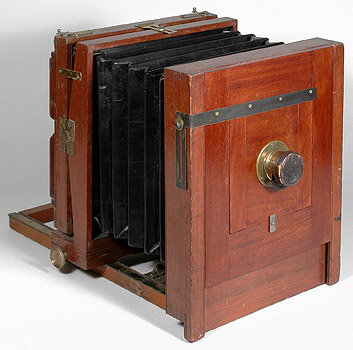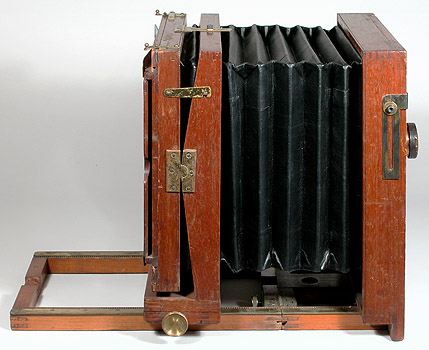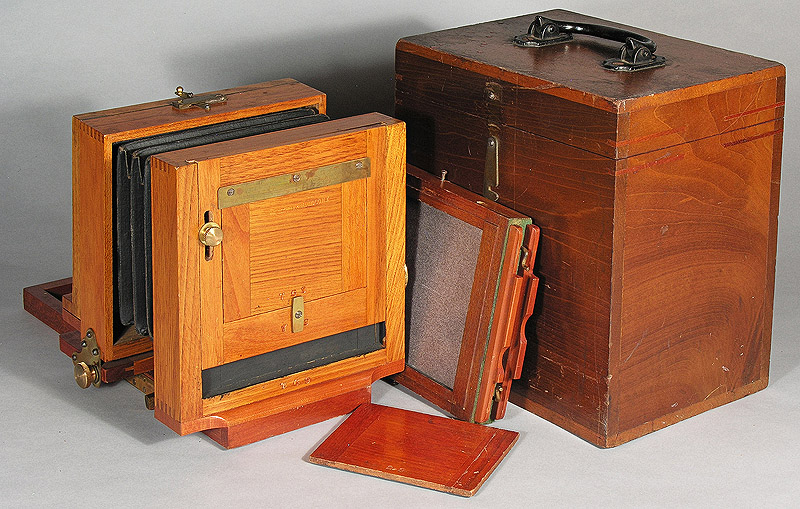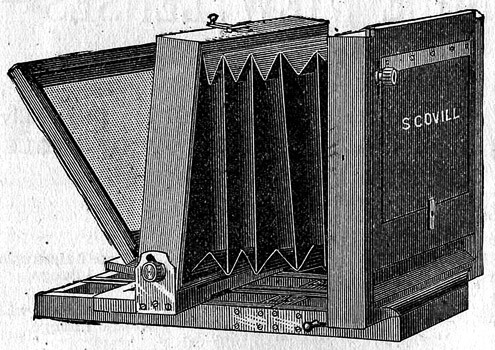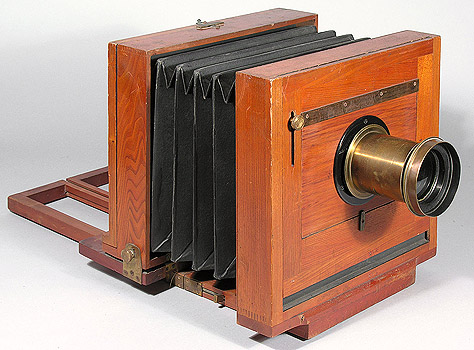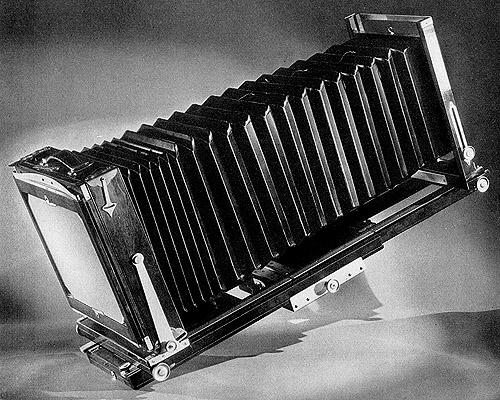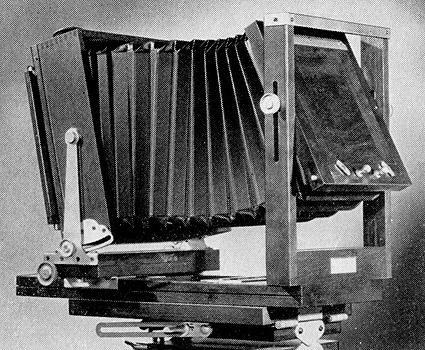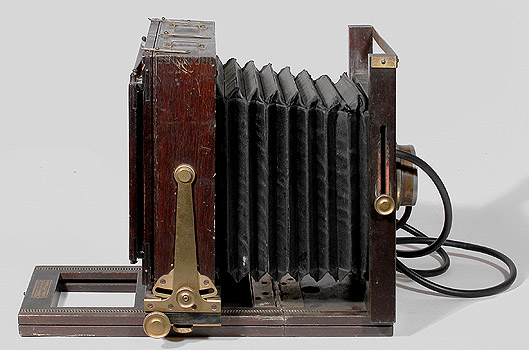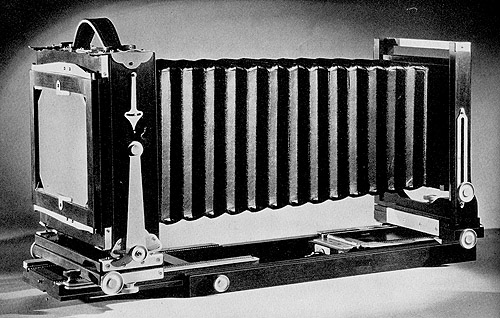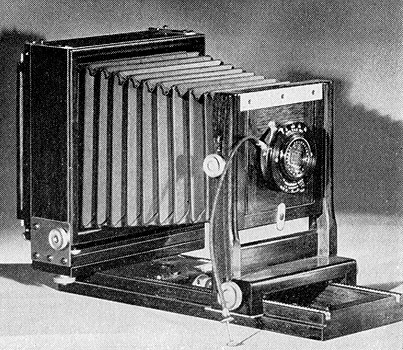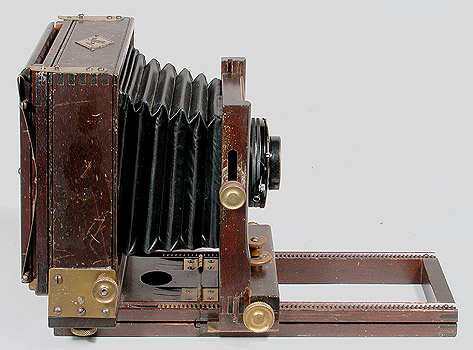Scovill Mfg. Co.
Field View Cameras
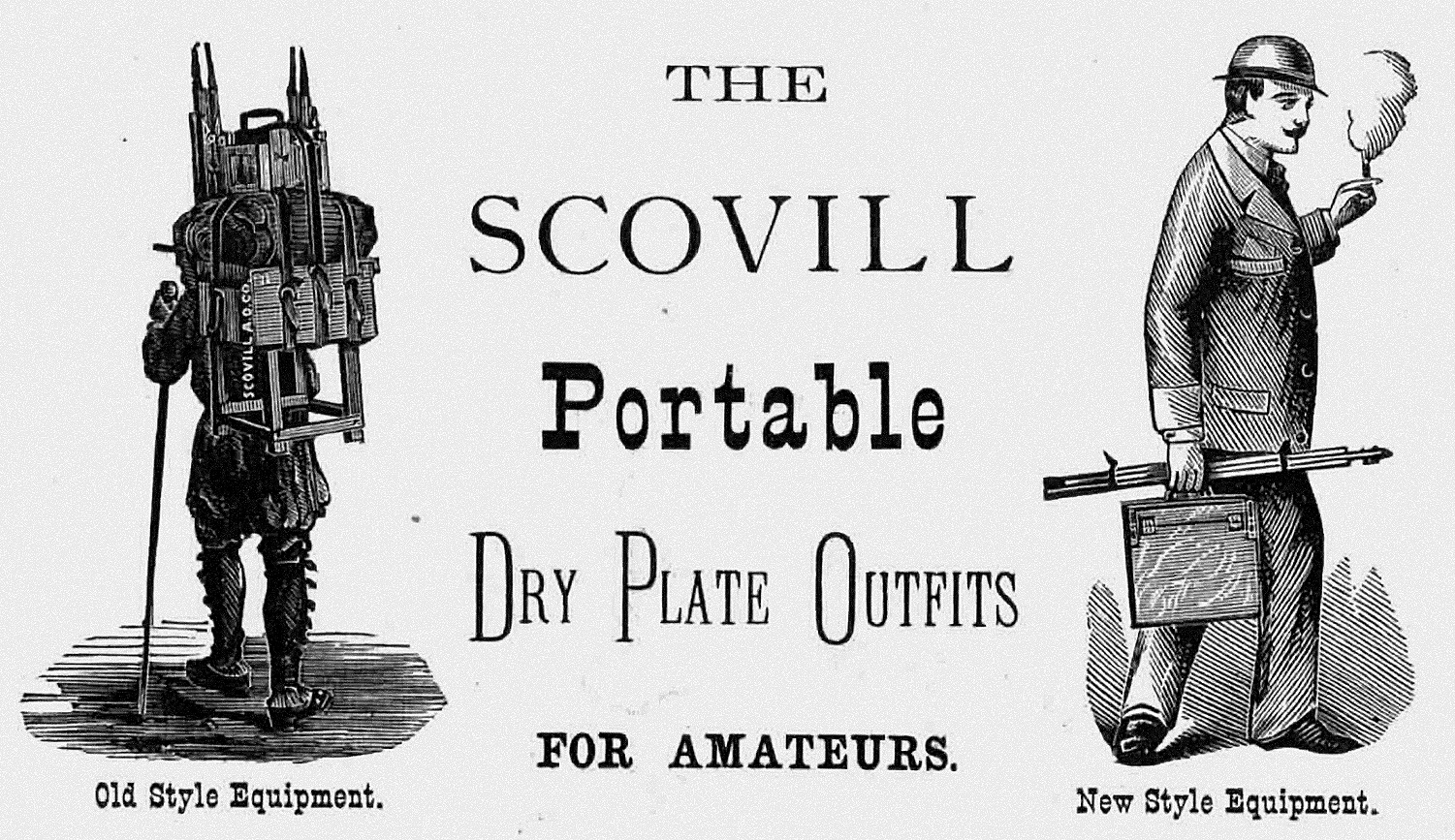
J.M.L. & W.H. Scovill, Waterbury, CT
(1802-1849), non-ferrous metal products (including Daguerreotype plates)
Scovill Mfg. Co., New York, NY (1849-1889)
Scovill & Adams Co., (1889-1901)
Anthony & Scovill (23 Dec 1901-1907 & see
The Anthony Companies)
ANSCO or Ansco Photoproducts, Binghamton, NY (1907-1928)
IG Chemie, later GAF, doing business as Ansco or AGFA-ANSCO, Binghamton, NY (1928-1939,
1945-)
Scovill Mfg. Co.:
Scovill Mfg. Co., in the dry plate era (~1870-~1910), was a major supplier of cameras, lenses and other photographic materials, purchasing or merging with the companies: Samuel Peck & Co. (1860), American Optical Co. (1867), E. & H.T. Anthony & Co. (1899), and later, in the film era: IG Chemie (GAF).
Scovill Mfg. Co. was founded in 1802, producing non-ferrous, mainly brass and copper, items for the rapidly expanding economy of the industrial revolution. Scovill's factory was located on the Nagatuck River in Waterbury, CT. Their principal products were buttons, wrought brass butts and hinges, furniture casters, kerosene oil burners and lamps, thimbles, and many other products made of copper plated with silver or German silver such as coach lamps and and reflectors.
Upon the introduction of photography to the United States in the late 1830's, Scovill was immediately capable of the manufacture of the silver-plated copper sheets required for the Daguerrotype photographic process. They rapidly became the main supplier of such plates as the number of photographers exploded.
Scovill gained the ability to manufacture the wooden parts of cameras by their purchase of Samuel Peck & Co. in 1860 (see below).
Samuel Peck & Co.:
Samuel Peck patented a device for holding Daguerrotype plates for polishing in 1850. In 1855, Samuel Peck & Co. was founded, and he entered into an agreement with Scovill Mfg. Co. The Peck factory was 12 miles downstream on the Nagatuck River to its confluence with the Housatonic River, and thence another 11 miles to Long Island Sound in New Haven, CT. It produced camera apparatus or boxes (using Scovill's brass hardware, of course), union cases (the cases for finished Daguerrotypes, and other photographic materials. By 1860, Peck had withdrawn from the business, and Scovill Mfg. Co. purchased Samuel Peck & Co. in that year. The factory continued to produce cameras and photographic materials.
American Optical Co.:
American Optical Co. was founded in 1856 in New Haven, CT (the same town as the Peck factory) to manufacture camera boxes, stereoscopes, and photographic accessories. It was incorporated in 1866, also as the American Optical Co., combining with or having purchased the partnership of the John Stock Camera Mfg. Co. and C.C. Harrison, both in New York City. The John Stock factory made the camera boxes and other wooden items and parts, and the Harrison factory concentrated on the lenses.
In 1867, Scovill Mfg. Co. purchased the American Optical Co. corporation, which became a division of Scovill. Until 1889, cameras manufactured at the American Optical factories were marked as such: American Optical Co., Scovill Mfg. Co., proprietors. American Optical cameras have either a German Silver-plated brass label, or their identity stamped into the wood.
Upon its acquisition, the American Optical-Stock factory had a line of cameras that included two general designs (straight bellows and tapered bellows) and at three tiers of construction/finish. In 1871, for their most popular tapered bellow view camera, there were three tiers: a best quality View Camera Boxes No. 1, a lowest quality View Camera Boxes No. 2, and a middle featured, plain View Camera Boxes.
The top quality cameras were made from fancier and/or denser hardwoods, and finished using a technique called French polish. During the process, the pores in the wood are filled by successive applications of shellac (or other solvent-soluble lacquer) - rubbing the wood with a rag containing shellac. The final polish is achieved by a light application of another rag charged with solvent (ethanol) only. The result is a mirror-smooth but thin finish that reveals and displays the mahogany wood grain.
The 2nd quality cameras were made from cheaper woods, some not even hardwoods. They were finished using varnish or black paint (called ebonized finish in the trade, which must have caused a lot of laughter among camera salesmen). A camera varnish finish, often applied in one coat, displays a constant thickness whether on the surface or in the pores. On a porous wood such as mahogany or sycamore, it ultimately must be applied thicker than a French polish finish, and also displays a dip or indentation at every pore.
Existing cameras marked American Optical appear to be made from better, fancier wood and finished better than existing cameras marked Scovill. This can easiest be explained by assuming that American Optical-marked cameras were made at one of Scovill Mfg. Co.'s camera factories and Scovill-marked cameras made at the other.
Cameras marked as American Optical were probably made at the traditional American Optical factory, that is, the former John Stock factory in New York City, and cameras marked as Scovill were probably made at the former Peck factory in New Haven, CT. This conclusion is suggested by the sizes of similar design cameras. For example, the popular Scovill Waterbury Camera had a counterpart of almost the same design but marked American Optical (American Optical Waterbury-type Camera). The sizes of all pieces of each camera are different - that is: if made in the same factory, they would require separate jigs and tools, not only separate woods and finish. It makes sense if, in fact, they were made in different factories.
In the 1860's and 1870s, the former Stock New York factory apparently continued to produce its normal multiple tiers of camera quality. In the middle 1880s and later, however, it appears that the lesser wood (sycamore rather than mahogany) and lesser finished cameras were tasked to the former Peck New Haven factory, while the complex, French polished and pricey cameras were made by the Stock-American Optical New York factory.
The two factories often produced cameras almost identical in construction, except that the American Optical cameras have better woods and that higher grade of finish - i.e. there is often a Scovill camera model that is a cheaper version of an American Optical model.
Scovill confused the issue of whether a given camera is American Optical or Scovill by not being consistent in advertising and catalogs, Catalogs may refer to one or another camera being American Optical, or may imply that the entire catalog is the American Optical line. Many of the ads for the cameras use the same engraving to illustrate more than one model. For example, catalog 1 will advertise model 1 and model 2 cameras using one engraving. Another catalog will advertise model 2 only, using the previous model 1 engraving. The result is that it is not easy to determine whether a camera ought to be described as an American Optical camera or a Scovill camera, or to determine which factory in which it may have been made.
The Scovill & Adams Co.:
In 1889, Scovill Mfg. Co. was re-organized as The Scovill & Adams Co. At this time, all cameras, whether from the American Optical factory or the Peck factory, were marked: The Scovill & Adams Co., New York. Regardless of marking, the disparity of finish between the factories continued, and it is usually obvious when a camera is from the American Optical factory or from the Peck factory.
The camera lines were streamlined, and 1889 marks the extinction of many models and the introduction date of others. It is not a coincidence that, at this time, the Eastman Kodak Co. was rapidly expanding their roll film business and had introduced the extremely popular Kodak (push the button and we do the rest).
The Anthony & Scovill Co.:
Throughout the period 1870-1900, American Optical-Scovill and E. & H.T. Anthony & Co. were the two largest American manufacturers of photographic Cameras and supplies. They were competitors, often having similar camera models similarly priced. They both thrived in the era when a small number of committed amateur hobbyists or itinerant professionals carried their large wooden cameras and tripods into the field. But the Kodak introduced the entire population to carrying a small box that could capture their family images.
Anthony and Scovill merged in 1901. Due to the economic pressure of mainly Kodak, this was end of the line for the beautiful and lovingly made American Optical cameras - the Anthony and Scovill catalog of June, 1901 contains only view cameras from the Anthony line. Even when French polished, the Anthony & Scovill Co. camera finish does not approach the smoothness of the American Optical product.
The Anthony & Scovill Co. should have been viable during the introduction of roll film cameras, since they had purchased the Goodwin Roll Film Patent, a vaguely worded patent of flexible photographic film on a roll. The Eastman Kodak Co. had been producing roll film since 1889 the Kodak roll film cameras came to dominate the industry. In 1902, The Anthony & Scovill Co. sued Eastman Kodak Co. for patent infringement, and won the case in 1913, receiving five million dollars in the following year. But the damage had been done- Anthony & Scovill was now a minor player in a photographic industry where Kodak ruled.
ANSCO and Ansco Photoproducts:
In 1907, the name The Anthony & Scovill Co. was shortened to ANSCO. The era of the amateur hobbyist photographer was over. ANSCO may not even have manufactured view cameras at all - they are absent from ANSCO catalogs.
Agfa-Ansco:
In 1928, ANSCO merged with a German firm Agfa to become Agfa-Ansco. It was merged with other German companies in 1929 by a Swiss holding company, IE Chemie, later named GAF. During this time, view cameras were manufactured, but all marked Agfa-Ansco up to the Second World War. These are the last view cameras of interest. The company was sold to American investors as enemy assets in the 1960s.
Problems in American Optical / Scovill identification:
It has been noted that cameras marked "American Optical" generally are made and finished better than cameras marked "Scovill". This is probably due to a company policy, but more than a little due to the fact that the Scovill Mfg. Co. (proprietors of the American Optical Co.) maintained two separate factories: the former Peck in New Haven, CT, and the former John Stock factory in New York City.
Scovill catalogs and advertising often, if not always, featured a mixture of cameras made in the American Optical factory and cameras made in the Scovill factory. They were equally as often lax about saying whether a given camera was an American Optical or a Scovill product. This has naturally led to some confusion regarding the maker of a model. Despite the fact that I have a separate thumbnail web page for each of the companies (so as to limit the number of models on each page), it can be difficult to assuredly assign a camera to one or the other maker/factory.
In addition, several instances are known of models which appear to have been made by both factories, but only advertised to have been made by one. A common example is the Scovill Waterbury and American Optical Leader. The Waterbury is a common amateur rear-focusing, single swing, front rise, non-tapered bellows camera made of varnished sycamore wood and un-lacquered brass (except on its edges where the varnish from the wood has slopped over onto the brass - apparently, the varnish is applied after assembly). The Leader is virtually the same design, but made from dark, tight-grained, French Polish lacquered mahogany and fancy, draw-filed brass hardware on which all the screw slots have been laboriously aligned. The Waterbury is in every catalog, whereas the Leader seems to only appear in remainder sale lists. Other examples are the Scovill Acme and the American Optical Acme, and the Scovill St. Louis and the American Optical St. Louis (discussed on the Scovill page).
For these reasons, the identification of a particular camera may appear on either or both thumbnail pages.
American Optical / Scovill Patents:
243,136; Jun 21, 1881; plateholder (original patentee: J.
Milton Howe). This patent was also used by Blair.
277,787; May 15, 1883; blackboard slide for plateholder (patent held by Blair, but Scovill
used it by royalties paid)
283,589; Aug 21, 1883: Flammang revolving back (always stamped Flammang's)
328,664; Oct 20, 1885: rod & cylinder system for making bed rigid (by Flammang, and
often stamped Flammang's Patent)
376,983; Jan 24, 1888: plate holder (original patentee:
Willard H. Fuller, assigned to Scovill Mfg. Co.).
402,154; Apr 30, 1889: print frame (original patentee:
Willard H. Fuller, assigned to Scovill Mfg. Co.).
428,809; May 27, 1890: plate holder
(original patentee: Willard H. Fuller, assigned to The Scovill & Adams Co.).
436,891; Sep 16, 1890 (Scovill & Adams): Albion-type revolving tripod ring in base and
braced front standard that folds into base (but Albion was advertised in 1888)
Scans of number of catalogs can be found here. Scans of American Optical and Scovill catalogs are here.
Scovill and Anthony & Scovill Models
ANSCO and AGFA/ANSCO Models
![]()

















